 

|
|
|
|
Mid-week Progress on Switch Installation!
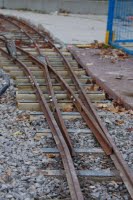 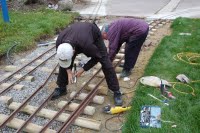 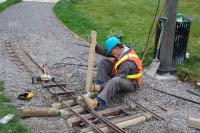 Click on each image for a closer look! Click on each image for a closer look!. Thursday afternoon was another productive effort by a TRHA team who spent the afternoon building track. By the time we finished about six o'clock, the second switch at the platform crossover/wye exit location was in place and 2/3 connected. The south wye switch at the depot lead track now has its frog point installed and point blades in place but not finally fitted. . It was a good productive afternoon and gives us a head start for the weekend. We are now down to only one more switch and a "mess" of crossing flangeways to complete before the main loop can see its first test train. . Posting by Michael Guy; Pictures by Lance Gleich . 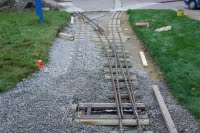 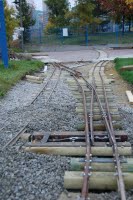 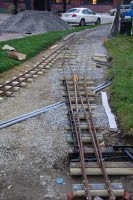
TheTH&B Caboose after Cleanup
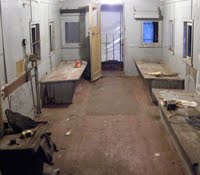 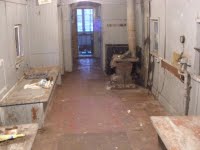 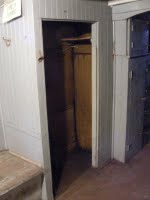 Click on each picture for a closer look! Click on each picture for a closer look!. We took a series of pictures of the interior of the TH&B caboose after it was cleaned up by last weekend's work crew to aid in the planning of its restoration. The above pictures show it as it appears after that cleanup work was completed. . Posting by Russ Milland; Pictures by Michael Guy .
More Progress on Restoration of Don Station
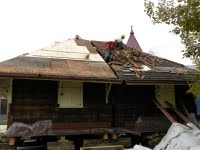 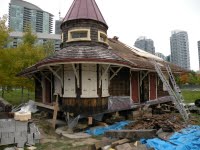 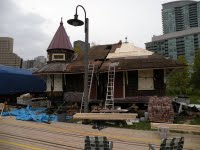 Click on each picture for a closer look! Click on each picture for a closer look!. These three pictures show that, now that Cabin D is nearing completion, the Murison restoration workers are beginning to address renovation of Don Station. Here we see them removing old shingles in preparation for the building to be pulled back together and lowered onto the foundation. . Posting & pictures by Michael Guy
More Progress on Restoration of Cabin D
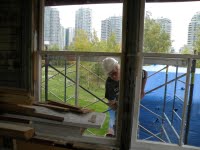 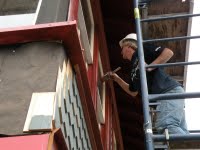 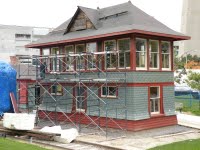 Click on each picture for a closer look! Click on each picture for a closer look!. The above three pictures of Cabin D show the Murison restoration workers putting final coats of paint on the exterior. The signal cabin is geting closer to restoration of its external appearance. . Posting by Russ Milland; Pictures by Michael Guy
Progress on Completing the Miniature Railway Trainshed
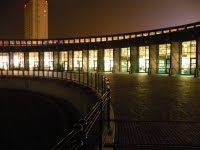 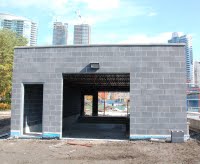 Click on each image for a closer look! Click on each image for a closer look!. At the left above, we see a fine show of the roundhouse from the turntable at 5:00 a.m. on a recent morning. . In the remaining shots we see that progress is being made on completing the trainshed. The steel roof has been installed. The roof will eventually be a "green roof" in keeping with ecological concerns. The interior shot of the miniature railway depot shows that the power panel is also now in place. . Posting by Russ Milland; Pictures by Michael Guy & Lance Gleich . . 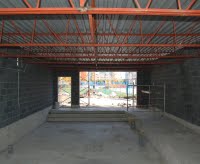 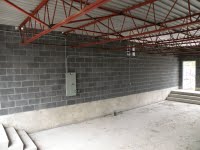 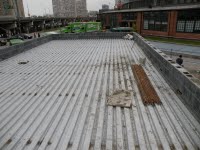
Weekend Report - Sunday's Progress
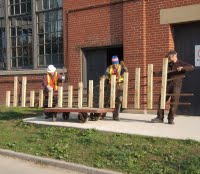 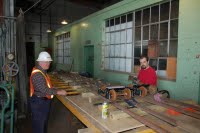 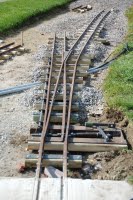 Click on each picture for a closer look! Click on each picture for a closer look!. The weather was kind, as forecast, today and we achieved the goal of placing a switch at the south end of the platform. . Festivities commenced about 9:30 and came to an end around 3:30 when the last two of us standing decided to finally called it quits. The good news is that as well as installing a switch, we were able to complete the next switch needed to complete the platform approach crossover. Although I was pushing to get both installed today and that did not happen, we are still several days ahead as the second switch was going to be next week's project. . Thanks everyone for a great weekend of work. We did really well. . Posting by Michael Guy; Pictures by Michael Guy and Lance Gleich . 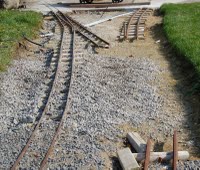 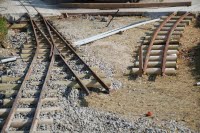 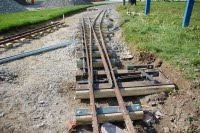
Weekend Report - Saturday's Progress
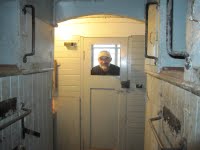 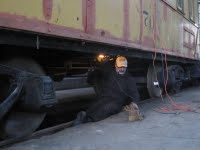 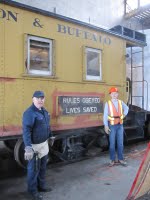 Click on each picture for a closer look! Click on each picture for a closer look!. 'Twas a lovely day no rain but we stayed indoors anyway. We all got so engrossed in the projects that when someone said "its four o'clock" the collective reaction was surprise - where had the day gone? . The TH&B van was emptied of junk and swept clean and the lights made to work again. We then recorded the interior after which the two tables were removed (gently) to improve access to the panelling. It seems likely that the three bunks/settees/storage lockers will need to be removed also as there is substantial rot in behind them. More investigation will take place next week. . Meanwhile we also attended to the Sweet Creek loco, blowing any water out of all the lines in preparation for freezing temperatures. A few of us then spent the rest of the day finishing off the mechanical details of the next miniature switch on the bench. This is now complete and will be installed tomorrow (Sunday). . Below, we find some of us inspecting a CNR handcart and steamer trunk newly donated to the the museum by Paul French. . Posting by Michael Guy; Pictures by Michael Guy and James Rasor . 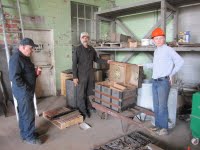 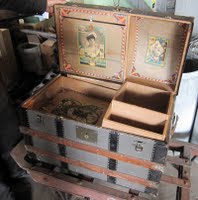 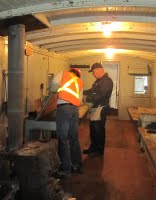
Field Trip Report: The Berkshire Scenic Railway
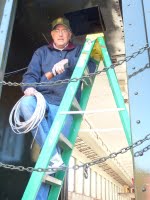 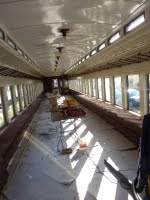 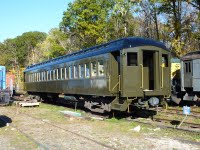 Click on each picture for a closer look! Click on each picture for a closer look!. Last week, we were vacationing in the Berkshire Mountains in the western part of Massachusetts about a 5 hour drive from the Canada border at Fort Erie. Always on the watch for heritage railway sites to learn from, I discovered the Berkshire Scenic Railway in Lenox, Massachusetts. They operate on weekends when the railway they use, the Housatonic Railway, si not moving freight down the line. The Housatonic is a Class III Railway operating in New England. The Berkshire offers the visitor a 90 minute round trip between Lenox and Stockbridge through the valleys of the Berkshires. . The railway was closed when visited it during the week. However, one of the 7 volunteers who operate the museum and railway was there and I had an enjoyable conversation with a kindred spirit. In the pictures above we find the volunteer, Paul, restoring one of their old clerestory coaches. In the pictures below we see a replica of a small yard masters office which they faithfully replicated including an authentic interior. The picture also shows the mainstay diesel used for their tourist train rides, an SW-xx switcher. They also have one of the Housatonic's back up RS-3 switchers in their yard which they use when five or more of their 8 Delaware, Lackawanna and Western Pullman passenger coaches built between 1911 and 1925 are pressed into service. Below you will see their string of old coaches. Not shown here is their fully restored New Haven caboose built by the Standard Steel Car Company in 1927. . Posting and pictures by Russ Milland . 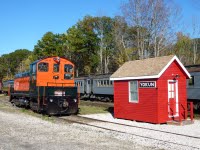 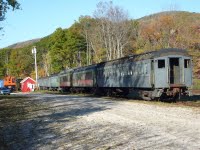 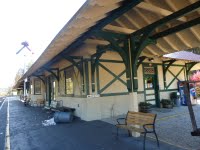
Historical Note: Night Train from Omemee
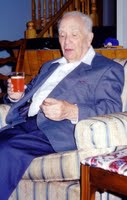 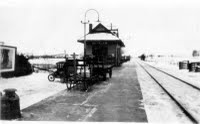 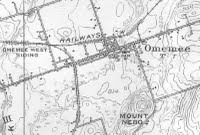 Click on each image for a closer look! Click on each image for a closer look!. Bob Dickson of the TRHA has provided us with a second letter written by his great uncle James William Campbell Dickson (as pictured at upper left). The first letter was published by us here. . Today's letter describes a trip from Omeemee (see map at upper right) to Montreal. The middle picture is of Omemee Station in 1927 taken by Bob Dickson's grandfather. . Here is Bob's story about the letter: . The Night Train from Omemee"My great uncle James Dickson started working for CN in Toronto in 1929 as secretary to the comptroller. In 1932 they moved the office to Montreal. He worked for CN for 44 years. My grandfather for 27 years. Both my grandfather and great uncle grew up on the railway as my great grandfather started working for the railways in 1883, with the Northern and NorthWestern R.R. in Georgetown as Station Agent. Later with GTR and CN until 1935 where he retired in Omemee. . I relate this information because my great uncle was a great story teller and I have many of his stories of the railroad. I have heard others talk of the service Via provides, some good , some bad. But the main theme running through them is how much better the service used to be. However they are mistaken. Here is one of my great uncle's stories "The Night Train From Omemee". I'm not sure of the date of his train ride, but the story was written in a letter to my aunt in 1964. . Bob Dickson, TRHA" . The letter is too long to post here but you can either open it or download it from the Resources page on the TRHA Website. Click here to access the letter. . If you have artefacts, stories or other items of historical railway interest to donate or make available to the Toronto Railway Heritage Centre, contact us.. For more information about Omeemee Station and the history of railways in the area, visit Charles Cooper's Railway Pages. . Posting by Russ Milland; Pictures, story and letter courtesy of Bob Dickson and the Dickson family; Omeeme Map from the Ontario Archives
Only Regularly Scheduled Steam-Powered Railway in Ontario in 2009!
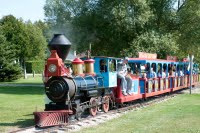 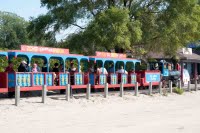 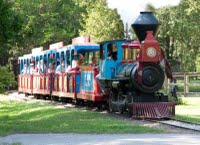 Click on each picture for a closer look! Click on each picture for a closer look!. This year there was only one regularly scheduled steam-powered passenger train operation in Ontario. The Huntsville and Lake of Bays Railway was closed this year to allow for construction of facilities for the G8 Summit in June of 2010. The South Simcoe Railway continues to work on rebuilding CPR 136, a wonderful old steam locomotive which had run for a number of years there before requiring further rebuilding. A few other steam locomotive in Ontario operate only on special occasions and excursions. . In Port Elgin, Ontario on the shore of Lake Huron, a steam driven passenger train, has run as the Port Elgin and North Shore Railway for many decades. This past summer, the railway operated excursion trains along the beach on a 1 mile (1.6 km) route in downtown Port Elgin. The round trip took approximately 20 minutes. While it is now closed for the winter season, we look forward to visiting it next year. . Posting by Russ Milland; Pictures by Peter Stamford of Port Elgin . 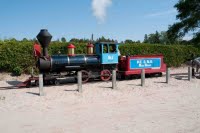 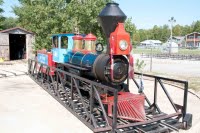 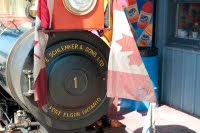
Today is CP #7020's 65th Birthday!
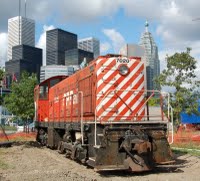 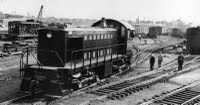 Click on each picture for a closer look! Click on each picture for a closer look!. CP #7020 is a Class DS10-b locomotive and carries serial #72855. It has been preserved as part of the Toronto Railway Heritage Centre collection. In the picture at the upper left taken by Lance Gleich in July of 2009, #7020 is dsiplayed today at Roundhouse Park. More information about #7020 can be found here on our website . As mentioned in earlier TRHA News postings, Derek Boles, TRHA's historian, publishes a daily posting on the Toronto Railway Heritage Yahoo Group List. These postings document major events in Canadian history that happened on that day of the year. Among the items in today's posting is the following: October 18, 1944: (65th Anniversary)"Toronto newspapers report favourably on the new diesels being delivered to the Canadian Pacific Railway for switching freight cars in West Toronto, Parkdale and various downtown yards. The first of these was No. 7020, an S-2 switcher built by the American Locomotive Compnay (Alco) in Schenectady, New York. The municipal enthusiasm for this new type of locomotion was due to concerns over the amount of smoke being discharged by the estimated 117 CP and 175 Canadian National steam locomotives that operated daily within the city of Toronto. No. 7020 was donated to the City of Toronto in 1986 for inclusion in the railway museum at the John Street Roundhouse, where the locomotive is currently undergoing a cosmetic restoration." . If you wish to read these daily postings from Derek, simply join the Yahoo Group by clicking here.. In the picture at the above right from the City of Toronto Archives, we see #7020 on delivery in 1944. In the picture at the left below by Pete McKintosh, we find CP Rail #7020 working West Toronto. In the picture at the right below by Dave More, we see #7020 clattering across the diamond at West Toornto headign towards Lambton in 1980. . Posting by Russ Milland; Pictures by Lance Gleich, Pete Mackintosh, Dave More (Helmut G. Osterman Collection) and City of Toronto Archives . 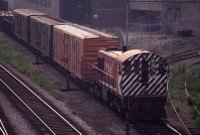 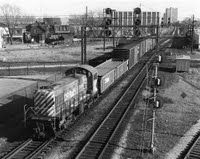
Weekend Work Report: Mini F7 Returns to Roundhouse Park!
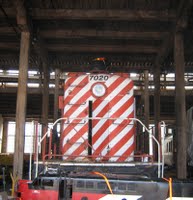 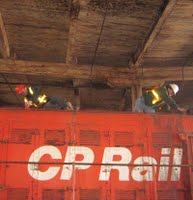 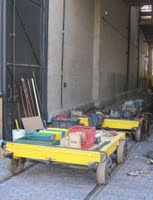 Click on each picture for a closer look! Click on each picture for a closer look!. Here is James Rasor's take on today's work party session: . "It was a good work party today. While some of the members were at the Simcoe County Museum's Last Blast, a small team stayed and did some much needed maintenance jobs at the Roundhouse. With some help from Michael Guy, who managed to be in both places today, we moved some equipment to Stall 15 that will be needed later. We also started the clean-up on the CP7020 roof to prepare it for priming it with paint for winter protection and managed to get the headlight and number plates illuminated again. Another small maintenance task was to give the tie carts a good cleaning, remove garbage, and reorganize the carts for the next work party. The Fowler box car had its platform and stair brought back into place at its door to allow the crew easier access into it - all that is needed now is electrical to hook up the lights inside. And best of all for the day, Russ Milland returned Michael Guy's CN F7 Miniature Railway locomotive from the Golden Horsehoe Live Steamers' track in Hamilton where it has been seeing great service pulling passengers all summer. We all hope to see this locomotive up and running at one of our next work parties pulling our miniature railway MOW (Maintenance of Way) train and testing our new miniature railway track which is very close to being finished." . Note also in the lower right picture that we were visited by a couple of fellows on bicycles built to ancient old designs. . Posting by Russ Milland; Pictures by James Rasor and Bob Dickson . 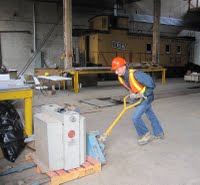 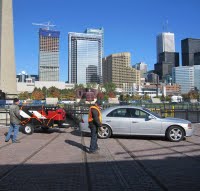 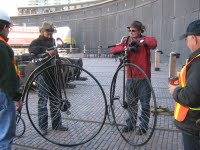
Next TRHA Union Station Tour on Saturday, October 31st, 2009
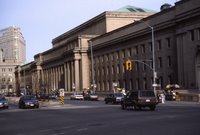 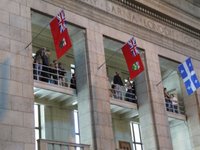 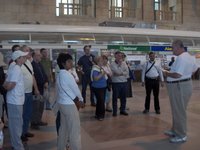 Next TRHA Union Station Tour on Saturday, October 31st, 2009 Next TRHA Union Station Tour on Saturday, October 31st, 2009
.
Click on each picture for a closer look! . The TRHA offers tours of Union Station on the last Saturday of each month at 11 a.m. Cost is $10 each payable on arrival for the tour. Reservations are not necessary and those interested should meet by the Traveler's Aid counter in the centre of the Great Hall at 10:50 a.m. For more about these tours, click here.
Today is the 80th Birthday of the CPR John St. Roundhouse!
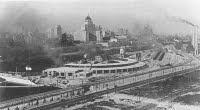 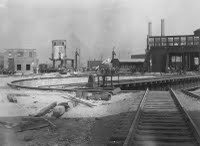 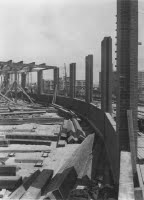 Click on each picture for a closer look! Click on each picture for a closer look!. As most of you know, Derek Boles, TRHA's historian, publishes a daily posting on the Toronto Railway Heritage Yahoo Group List. These postings document major events in Canadian history that happened on that day of the year. Among the many items in today's posting is the following: October 15, 1929:"The Canadian Pacific Railway Locomotive and Car Facilities opens at the foot of John Street, replacing an older facility first opened in 1897. The new facility was 17 feet higher, required for access to the new viaduct into Union Station. Railroaders continued to call the facility "John Street," even though its actual connection with the street disappeared some months earlier with the dismantling of the John Street bridge across the tracks. John Street contained 43 structures, several miles of track and covered nearly 16 acres of property. It was one of only three roundhouses in Canada that exclusively serviced passenger locomotives. The engines were moved in and out of the 28-stall roundhouse on a massive 120-foot turntable, the longest in Canada. The roundhouse was the first to use the "direct steam process" where steam was pumped into the locomotives so that they did not have to have their boiler fires going in order to move in and out of the building. This created much better visibility and safer working conditions for workers and meant less smoke inhalation. . Up to 150 men worked in the roundhouse 24 hours a day. The locomotives serviced there were so attractively maintained that their appearance became known among railroaders as the "John Street polish." After the original 1897 roundhouse was demolished, four more stalls were added in 1931 for a total of 32. Provision was made for 16 more stalls but the Depression resulted in reduced traffic and these were never built. . The passenger car yard and facilities were almost twice the size of the adjacent CN Spadina yard and could accommodate up to 450 full- length passenger cars. John Street was decommissioned in 1988 and turned over to the City of Toronto for conversion to a railway museum. In 1990, the facility was declared a National Historic Site because it was an "architecturally and historically important surviving reminder of steam technology and the role of transportation in the City of Toronto." . If you wish to read these daily postings from Derek, simply join the Yahoo Group by clicking here..
In the picture at the above left, we see the finished roundhouse against the Toronto skyline of that era. In the remaining pictures, we see the roundhouse under construction.
. Posting by Russ Milland; Pictures from the City of Toronto Archives . 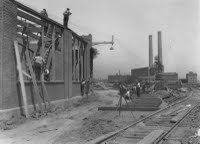 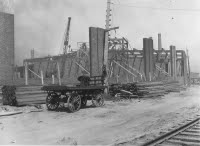 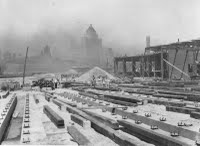
Local Events: The Last Blast at the Simcoe County Museum - Saturday, October 17th
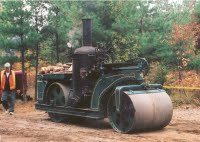 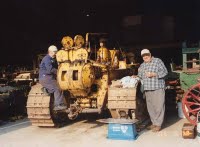 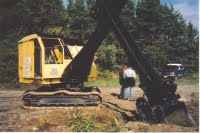 Click on each picture for a closer look! Click on each picture for a closer look!. This coming Saturday, October 17th, the Simcoe County Museum (just North of Barrie, Ontario) and the Historical Construction Equipment Association of Canada (HCEA) presents their last event of the year - The Last Blast. The HCEA is "dedicated to the preservation and restoration of heavy construction equipment and the history of the people in the construction industry that helped to build Canada." Here is more information from them on the event: "Start your engines and head to the Simcoe County Museum for one of the largest displays of working historic construction equipment in Canada! The Simcoe County Museum and the Historical Construction Equipment Association of Canada present our annual Last Blast at the Simcoe County Museum on Saturday, October 17th, 2009. Ride out to the gravel pits on a people mover for a guided tour. See live demonstrations of steam powered equipment, vintage road building, rock crushing, grading, hoisting and much more. Wander through the displays of vintage tractors, classic trucks and other historic equipment set up around the Museum grounds. Each year we power up pieces of our heritage equipment for one last blast before the winter, and you are invited to come see it. This is a family event guaranteed to rev up the inner child in everyone! . Visitors are invited to spend the day, stroll through the Museum grounds and visit our permanent displays. The Friends of the Simcoe County Museum will be on site all day, serving delicious hot food at our refreshment stand. Event hours are 10:00 a.m. to 4:00 p.m. Admission rates are: Adult $4, Senior/Student $3.50, Child $2.50, Preschoolers free." . The museum is a little over an hour's drive from Toronto and is located at #1151 on Highway #26 a few minutes north of both Barrie and Highway 400. Take the Highway 26/27 exit on Highway 400 and go north. . Click on this link - LastBlast.pdf - to download their brochure. Posting by Russ Milland; Pictures from the HCEA website.
Dramatic Changes over 38 Years in the Roundhouse Park Environment!
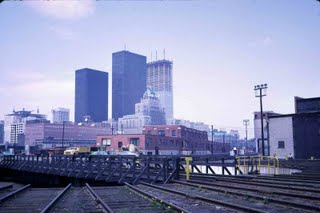 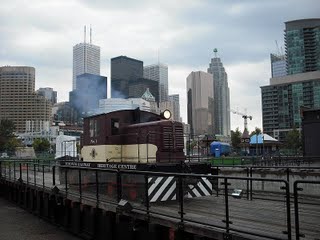 Click on each picture for a closer look! Click on each picture for a closer look!. The above pair of pictures dramatically show the changes at the John St. Roundhouse and in the city skyline over the past 38 years. The picture on the right was taken by James Rasor a few days ago. . The picture at the upper left was taken from much the same spot on June 4th, 1971 by Doug McFadgen. Immediately behind the turntable is CP's "stores building", which was used for the storage of various materials and also housed some offices and workshops. The CP repair shop is out of sight on the left of the picture. To the right of the TD Centre's black towers, we see Commerce Court under construction. . At the left of the picture we also see the CN Express building opened in 1929 and behind that the higher rise CNCP Telecommunications building opened in 1954. In the days before deregulation of the telecommunications industry, the only competitor to the Bell and other regional systems was CNCP Telecommunications. This business had evolved from the CN's and CP's telegraph business and lasted until 1989 when it was acquired by Rogers. . Posting by Russ Milland; Pictures by Doug McFadgen and James Rasor
Weekend Report: Part 2 of 2 - Reaching to the Trainshed!
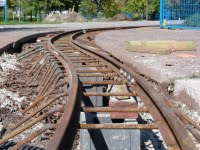 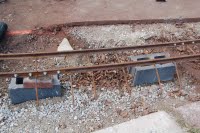 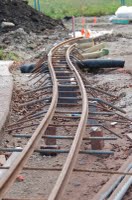 Click on each picture for a closer look! Click on each picture for a closer look!. TRHA crews have been steadily laying track towards the new miniature railway turntable and trainshed for the past week. In the photos above, we see that as of Saturday afternoon, they had made great progress laying the "ramp" leading to the trainshed. . In the pictures below we see that the contractors have also made progress on installing the roof support framing in the trainshed. In the last photo at the lower right, we see the final gap in the railway remaining to be completed once construction is complete in that area. . Posting by Russ Milland; Pictures by Lance Gleich; Michael Guy & Russ Milland . . 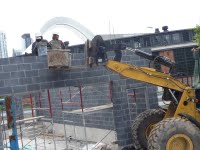 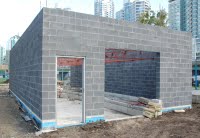 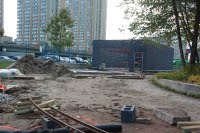
Weekend Report - Part 1 of 2 - Finishing the Crossing
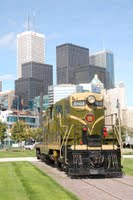 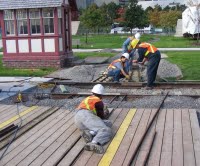 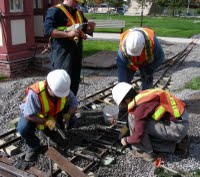 Click on each image for a closer look! Click on each image for a closer look!. We open this posting with a great shot of #4803 against the city skyline by Lance Gleich. . This weekend's work crew addressed the many different tasks involved in the completion of the crossing of the mainline by the miniature railway just north of the station platform as can be seen in the remaining pictures above and below with the finished crossing shown in the lower left photo. . Posting by Russ Milland; Pictures by Lance Gleich & Michael Guy . 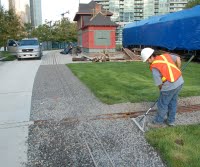 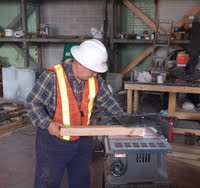 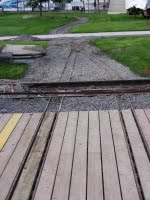
Switch Installation Progress in the Past Week!
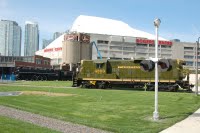 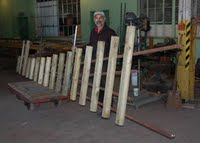 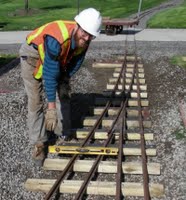 Click on each for a closer look! Click on each for a closer look!. At the upper left, we see the view greeting our work crews as they made further progress on the installation of the switches for the miniature railway at Roundhouse park. Our TRHA crews were also able to complete the bit of 'Y' track heading towards the mini depot. Due to the extreme slope of the ground in this area we were building track in free space rather than on a roadbed but we got it done. In the middle picture above we see one of the prefabricated switches ready for installation. In the remaining pictures we see the switch just north of the crossover and beside the crossing shanty being installed and finally being in place. . Posting by Russ Milland; Pictures by Lance Gleich & Michael Guy . 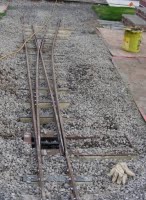 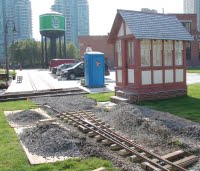 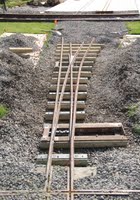
Roundhouse Park from Above! - Part 2 of 2: Binging It!
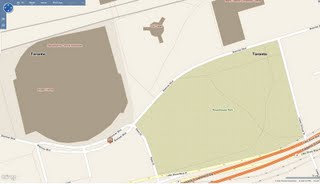 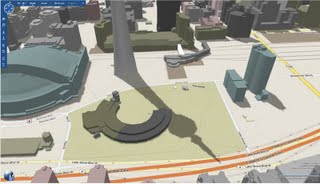 Click on each image for a closer look! Click on each image for a closer look!. Continuing on our theme of "Roundhouse Park from Above", we now turn to Microsoft's Bing Maps service (formerly Windows Live Maps). To see these images online and others at Bing Maps, click here or enter the address of Roundhouse Park - "255 Bremner Blvd, Toronto, ON" at Bing Maps. . In the image at the left above, we see the street map for the Roundhouse Park area with Roundhouse Park being specifically named. At the upper right is the 3D street map version which adds the outline of the Roundhouse itself and allows you to look at the landscape from an angle of your choice. . Bing Maps also offers an aerial view as shown at the left below. At the right below, we see another "bird's eye" version of the aerial view which lets you look at Roundhouse park from the angle of your choice. . Bing Maps also has the capability of adding points of interest with photos to the maps in its "collections" feature. While you have Roundhouse Park centred in your map at Bing Maps, click on "collections" and then click on the collection (created by us) named "Toronto Railway Heritage Centre" and you will find a collection of points of interest in the immediate area as well as for Roundhouse park itself. We will be adding to this collection in the near future. . Posting by Russ Milland; Images from Bing Maps. . 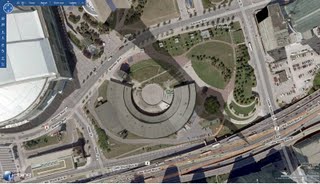 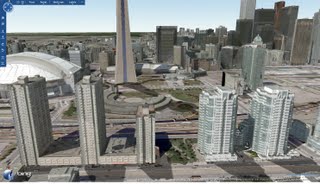
Roundhouse Park from Above! - Part 1 of 2: Googling It!
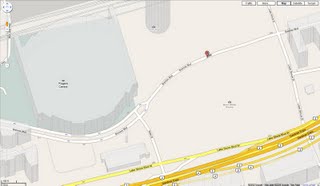 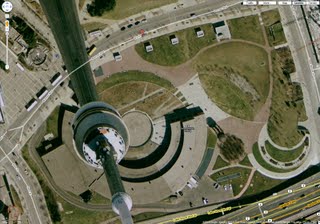 Click on each picture for a closer look! Click on each picture for a closer look!. Google Maps and Microsoft's Bing Earth are two exciting services that have appeared on the Internet in past few years. They provide us with the opportunity to explore areas through online maps, satellite images and overlaid photos and videos and even links to Wikipedia. In this pair of News postings, we will show how Roundhouse Park appears in this media and encourage you to go exploring yourselves. . If you go to Google Maps and enter the address for Roundhouse Park (255 Bremner Blvd, Toronto, ON) , you will see the street map for the area as shown in the image at the left above. If you switch the view to "aerial", you will see the satellite image for Roundhouse Park (as shown at the right above) with the CN Tower overshadowing the Roundhouse. As you can see, this satellite picture is quite dated as it was taken well before park renovations began. . Over the past few years, Google has been sending photographics vehicles to take 360 degree panoramic images of city streets so that you can click on a spot on a street and then see and rotate a visual image as if you were standing at that spot. To do this, click on the little orange human figure at the top of the vertical zooming scale at the upper left of the Google image and drag that figure onto a spot on any of the streets bounding Roundhouse Park. . Below, we show two of the many views that you can access through this feature. In the first one, we see an image taken from the Gardiner Expressway of the south side of the Roundhouse. In the second, we have a view from Bremner Boulevard. This second view dates the photography session closely as we find #6213 waiting to be unloaded from the framework used to move her to Roundhouse Park. This picture was then taken this year in June of 2009. . When viewing the maps in Google, you can also click on the drop menu menu under "more" in the upper right menu bar and see locations of pictures and videos which have been added to the map. However, if you click on any of these, you will find that most are of other local sites such as the CN tower at the moment. . To be continued!. Posting by Russ Milland; Images from Google Maps. 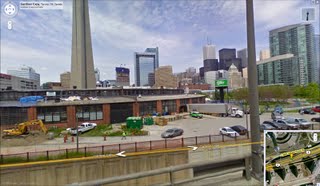 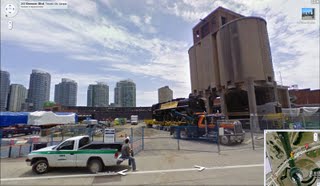
CN F7 #9159 - A 58 Year Journey - Part 2 of Several
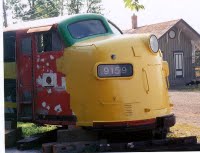 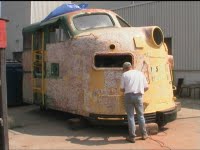 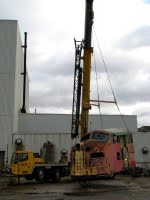 Click on each picture for a closer look! Click on each picture for a closer look!. In this TRHA News posting, we continue to follow the story of the F7 #9159's cab as told by Barry Silverthorn: "Having purchased the cab and pilot from Century Locomotive Parts, I had the cab trucked to Waterford, Ontario. I removed parts that could be stolen or vandalized and applied a temporary coat of rust-paint to protect it as shown in the picture at the upper left. . The F7 cab then sat in Waterford, Ontario for seven years. . In June of 1998, the cab was moved to Brantford, Ontario. Some of the extra steel was torched away to make it lighter. Equipment that wasn't original, like the MU boxes and ditchlight mounts, was removed. I used a high-speed grinder to remove eight coats of paint, up to 1/16" thick. It took three days of grinding to remove the top layers of paint in preparation for sandblasting. This method is slower than sandblasting but much less expensive. In the picture in the middle above, this work is in progress. . In late-2007 an agreement was made in principle to donate the cab to the TRHA for use as a display and console for a computerized train simulator. It was moved to Western Mechanical for sandblasting in January of 2008 as shown in the pictures at the upper right and the lower left." . Western Mechanical has now completed cleaning up the F7 Cab and repainting it in a black protective paint as shown in the two pictures at the lower right. The next step will be to move the cab to Roundhouse Park. . Posting by Russ Milland; Pictures by Barry Silverthorn, Western Mechanical and Dave Wetherald . 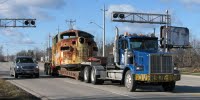 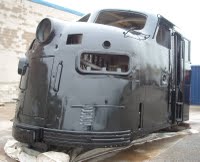 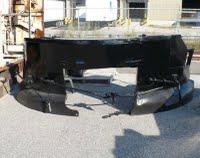
CN F7 #9159 - A 58 Year Journey - Part 1 of Several
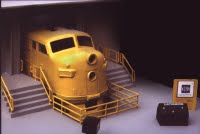 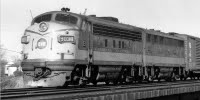 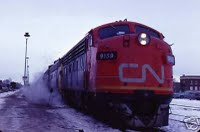 Click on each picture for a closer look! Click on each picture for a closer look!. Given the tremendous advances in computer based systems technology, a key feature of modern museums are interactive exhibits which involve the visitor. Our miniature railway is an example of such an interactive experience. Another key element planned for the Toronto Railway Heritage Centre is a full sized railway simulation system using an actual diesel cab integrated with modern computer-based railway simulations software. In this series of TRHA News posts, we will track the progress so far and the history of the diesel cab which we plan to use for this purpose. In the picture at upper left we see an example of such a museum display of an F7 cab. . The cab that we are planning to use is being donated to the museum by Barry Silverthorn. Here is the story as told by Barry of the cab and the engine of which it was a part: "Originally numbered 9038, the F7 numbered 9159 was built in June of 1951 at General Motors Diesel in London, Ontario, Canada, during the first year of the plant's operation. In the photo in the middle above we see an F7 in the gold and green livery that CN used at that time. The locomotive was rebuilt in the early-70's and painted in the CN's new "zebra-stripe" scheme as seen in the photo at the above right. . After 40 years in both freight and passenger service between Quebec and British Columbia, the unit was scrapped in the spring of 1991. I purchased the cab and pilot from Century Locomotive Parts near Montreal, Quebec. The cab is show in the photos below. I had the cab trucked to Waterford, Ontario as shown in the picture at the right below." . To be Continued. Posting by Russ Milland; Pictures by Barry Silverthorn . 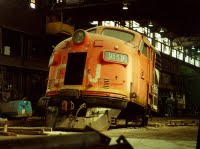 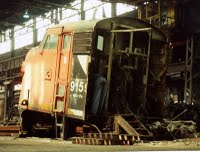 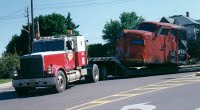
Weekend Report - Part 3 of 3: Unwrapping the TH&B Caboose!
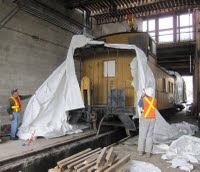 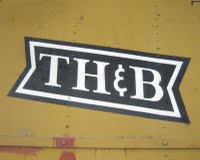 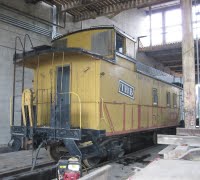 Click on each picture for a closer look! Click on each picture for a closer look!. In the final final part of our weekend report, we turn our attention to our TH&B caboose. After a lunch break on Saturday, we removed the "shrink-wrap" which had been used to protect it from the elements while it was stored outside during roundhouse renovations. We then removed the wood panels which sealed the doors and windows and followed through with an inspection tour of the interior. The pictures below show the state of the interior of the caboose. We will now begin our assessment of the condition of the caboose and begin to plan for its restoration. . Posting by Russ Milland, Pictures by James Rasor . 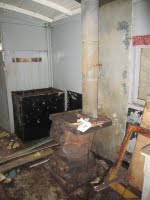 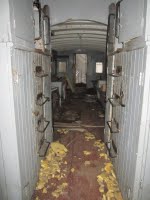 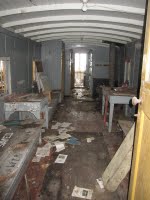
Weekend Report - Part 2 of 3: Inside Workers Progress!
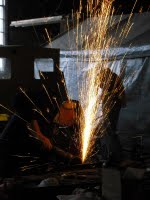 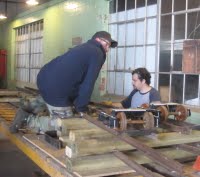 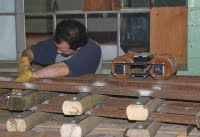 Click on each picture for a closer look! Click on each picture for a closer look!. Inside the Roundhouse on Saturday, a number of our volunteers worked on a variety of metal working projects including the miniature switch destined for the north end of the station platform ( as shown in the pictures above). We stayed with this work until after six p.m. But when we left for the day, we were rewarded by our test trucks of both gauges running through the switch in both directions successfully. . In the picture at the right below, we find Elwell the Crane in service moving the maintenance platform to a more appropriate location. In the two pictures at the lower left below, we find one of our crews doing maintenance on our wheeled scaffolding platform. . Posting by Russ Milland; Pictures by Michael Guy, James Rasor & Stephen Gardiner . 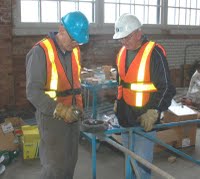 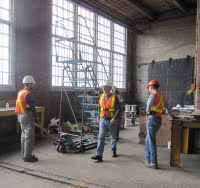 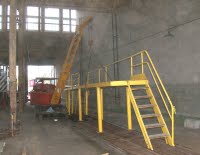
Weekend Report - Part 1 of 3: Running the Railroad!
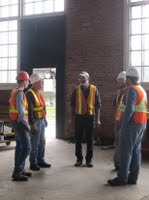 C C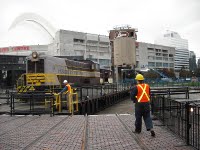 lick on lick on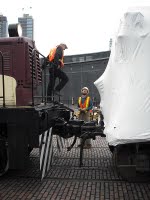 each picture for a closer look! each picture for a closer look!. The weather was a bit iffy at times today but we had a great turn out of nine TRHA team members and got everything on my list done plus some more besides. . We rarely need much of an excuse to fire up our CLC Whitcomb #1 and shuffle the locomotives and cars around but today we had a purpose - clear the three stalls space so we could move the work platform and benches to useful places and then bring inside the TH&B caboose and the boxcar. This we did with a full crew of fence-handlers and brakemen and it still took the better part of four hours. . Posting by Michael Guy; Pictures by James Rasor & Stephen Gardiner . 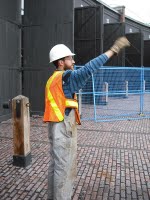 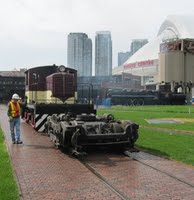 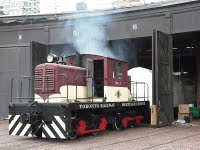
Historical Note: 1941 UCRS Excursion Report
What follows is a report of the first excursion held by the Upper Canada Railway Society (UCRS) on November 23, 1941. It has been copied verbatim from Number 3 of the UCRS newsletter, although it did not have that name yet and was simply three sheets of stapled mimeographed paper. I've added some information in brackets since the trains and engines are not as familiar to people today as they would have been in 1941. At the time, the New York Central had about ten passenger trains a day crossing southern Ontario between Buffalo and Detroit. . This is the first recorded case of an organized railfan trip operating out of Toronto. It's an amazing piece of nostalgia from 68 years ago that took place exactly two weeks before the Japanese attack on Pearl Harbor!. "The excursion which the Society held on November 23, 1941, though attended by a relatively small number, six members and one guest, was a great success from the standpoint of interest. The party assembled at a central point in Toronto at 9:30 AM on what was unfortunately, a dull and cold Sunday morning. From there the group, in two cars, headed west. . The first stop was at the CPR Cooksville station where an excellent view of # 21 (westbound Chicago Express) at high speed was afforded. It was hauled by (4-6-4 Royal Hudson) 2856 and consisted of a baggage car, two CPR sleepers, two Pullmans, parlor car, diner and observation sleeper. . The party halted next at Oakville to see CNR # 94 eastbound (overnight from New York City), hauled by (4-6-2 Pacific) 5250, with a Central Vermont baggage car, a cafe-parlor and three Pullmans. . The long and least interesting part of the drive then followed, over the Hamilton Mountain, where everything was covered by an early snow, and so to Waterford. . At the New York Central Station the excursionists arrived in time to see a fine passenger train hauled by Engine 5329 grind to a halt to pick up a flag passenger. All were struck with the extreme super- elevation of the curve right at the station, which is usually passed through at speed. The train contained two beautiful, streamlined coaches with folding steps. . From here the group drove a few hundred yards to the Waterford station of the Lake Erie and Northern electric line. The station sits on the southern rim of the valley through which the New York Central line passes; hence the LE&N crosses the Vanderbilt road on a long bridge of steel resting on concrete piers. From their position on this height the group saw what all agreed was the finest sight of the day - an extremely fast solid baggage train double headed by two of the famous Hudson engines 5362 and 5242. It was impossible to count the number of cars due to the strong wind which obscured the train for most of its length in dense clouds of smoke. . Also immediately along came the Lake Erie and Northern northbound electric and the car stopped in a very convenient place for taking photographs. As soon as this had passed over the bridge and made its meet with a southbound car, the latter arrived and the party boarded up for the trip to Port Dover on the shores of Lake Erie. . The group was fortunate in striking a very amiable crew and some of the members rode the whole trip in the cab with the motorman. Others found the conductor a source of much information. At the spot where the line crosses the CNR there is an interlocking plant, always set in favor of the big road. As a result, on every trip, the conductor of the electric train has to get out and change the plant over. He very graciously took the excursionists with him into the tower, part of the party on the southbound trip and the remainder on the return. . Following a 25 minute layover in Port Dover the train returned to Waterford, reaching there at 2:40 PM EDT. The New York Central again put on a good show. Two high-speed freight trains passed through at the excursionists' feet hauled by engines 2048 and 2026. Another passenger train was also seen hauled by Engine 4643 with two express refrigerators, five baggage cars and a coach. . The party then drove to Brantford, only stopping as it was leaving Waterford to view the track pans where the New York Central trains can take water without stopping. At Brantford the yards of the LE&N were visited, several passenger cars and freight motors being out in the open, where they could be seen. . At a point on the way to Hamilton the party pulled up by the CNR tracks in time to see # 183 (Toronto-Detroit) pass at speed with (Pacific) 5304, a baggage car and three coaches. Although it was moving along at a satisfactory rate it was impossible to avoid drawing comparisons between it and the really high speed witnessed on the New York Central. . At the smartly modern station of the Toronto, Hamilton and Buffalo in Hamilton the party saw No. 79 with New York Central Engine 4390, a baggage car, 3 TH&B coaches and two Pullmans. (There's no such train listed at this location; probably No. 801 with the sleepers for New York and Boston). . From Hamilton the group returned to Toronto, driving into Parkdale Station in time to see CPR # 37 (Royal York, Toronto-Detroit) with old Pacific 2235 and six cars. . Altogether about 200 miles were covered on the trip, which was planned by the excursion committee of the Society under the chairmanship of Mr. John McNabb. All of made the trip agreed that Mr. McNabb and his associates did a most capable job in planning it. There was not one occasion on which a planned connection was missed, nor one in which an unreasonable wait was necessary in order to see the train in question." . Posting by Derek Boles, TRHA Historian
Historic Note: Steam Plant Construction Started on October 1st, 1928
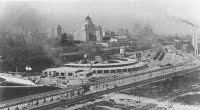 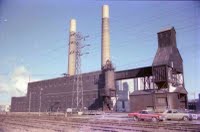 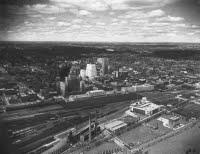 Click on each picture for a closer look! Click on each picture for a closer look!. As mentioned in earlier TRHA News postings, Derek Boles, TRHA's historian, publishes a daily posting on the Toronto Railway Heritage Yahoo Group List. These postings document major events in Canadian history that happened on that day of the year. Among the eleven items in today's posting is the following: . "October 1, 1928:. The Toronto Terminals Railway begins building the Central Heating Plant (CHP) at the northwest corner of York Street and Fleet Street (now Lakeshore Boulevard). The new facility replaced the old Toronto Hydro Scott Street plant, which was expropriated by the TTR for the building of the railway viaduct. When the Central Heating Plant was completed in 1929, it was the largest such facility in Canada. At its peak, the CHP could produce 330,000 pounds of steam per hour or an average of 600 million pounds annually. The plant provided steam heat piped through underground tunnels to a wide variety of railway facilities including Union Station, the CNR and CPR express buildings and the CPR John Street roundhouse, as well as supplying heat for individual passenger cars stored in the coach yard. The steam required for the Roundhouse's much vaunted "Direct Steaming Process" also came from this source. Moreover, the CHP also heated the Royal York Hotel, the Dominion Public Building, the Postal Delivery Building and the CN/CP Telecommunications building at Front and Simcoe Streets. Later the plant was converted to natural gas. In the 1980s the Toronto Terminals Railway decided to purchase their heating capacity directly from a commercial supplier and the Central Heating Plant was demolished in 1990." . In the black and white pictures above from the City of Toronto Archives, we can see where the steam plant was positioned just south of Union Station. In the colour picture above by Doug McFadgen, we have a close up view of the steam plant. In an earlier posting this year, we published a series of pictures by Norm Betts of the steam plant chimneys being demolished. Click here to read this posting. . If you wish to read these daily postings from Derek, simply join the Yahoo Group by clicking here.. Posting by Russ Milland
|


 Click on each image for a closer look!
Click on each image for a closer look!


































































































































